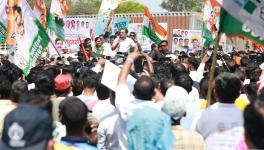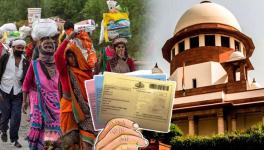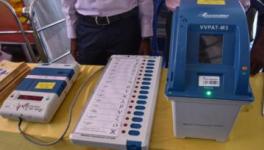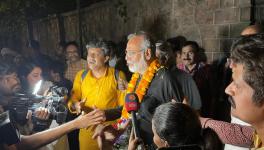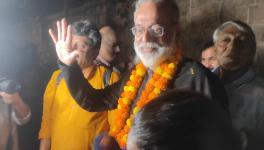Ayodhya: As Ram Temple Mega Event Nears, not a Single Brick Laid on Land Meant for ‘Grand Mosque’

Dhannipur (Ayodhya): It was 10:30 in the morning. A dense fog enveloped Masjid Mohammad Bin Abdullah, the proposed mosque in Dhannipur village. At first sight, goats and other livestock could be seen grazing on the vacant plot in the village.
Ignoring the chilly winter morning, children could be seen playing cricket on the land, unaware of the place that made international headlines over four years ago when it was officially allocated by the Supreme Court for construction of a mosque.
The alternate piece of land, located at Dhannipur village, is barely 20 km from the disputed 2.77 acres, where the historic Babri Masjid once stood before being demolished on December 6, 1992.
The villagers are still waiting for some activity on the vacant plot meant for the ‘grand mosque’ project, a law college, a 500-bed cancer hospital, a community kitchen that would feed about 1,000 poor people daily free of cost and other amenities.
However, the local residents of Dhannipur and Raunahi, Muslim majority villages, seem to have other plans than a ‘grand mosque’. They feel they urgently need a hospital, a government college and other government institutions more than a ‘grand mosque’.
"Every day, four-five people including politicians, religious scholars and journalists from across the country visit Dhannipur ever since this land was allocated for a mosque. Everyone promises that a ‘grand mosque’ along with a hospital, a college and community kitchen will be constructed. The villagers were ecstatic that the region's fortunes would change. But it has been over four years, but not a single brick has been laid here. God only knows when all this will come true," Mohd Sajid Khan, whose goats were grazing on the premises of the proposed mosque, told NewsClick.

Khan, who studied till Class 12, regretted not going for higher education as there was no government college in the area.
"What we need urgently is a government hospital and degree college more than a mosque. There are already 20 mosques in Dhannipur and Raunahi villages. In the absence of a hospital, we are forced to go to Lucknow or Faizabad for treatment,” a dismayed Sajid said.
Following the long-fought Babri Masjid-Ram Janmabhoomi title suit, the apex court in its 1,045-page judgment had ordered, in November 2019, the state government to allot 5 acres to the Uttar Pradesh Sunni Central Waqf Board for the construction of the proposed mosque, Masjid-e-Ayodhya, which is now called Masjid Mohammad Bin Abdullah at the alternative land. It is now under the supervision of the Indo Islamic Cultural Foundation (IICF) — a trust set up by the Waqf Board.
"The Babri Masjid verdict never said there was a Hindu temple before the Masjid, they just gave that land because the executive, judiciary, legislation is all dominated by majority. If there were neutral courts, the land would have been given to Muslims with compensation, and the criminals would have been sent to prison," Sohail Ismaili, who is disappointed that a grand mosque would never be constructed in his village, told NewsClick.
Ismaili, a religious scholar, argued that there was no point taking land in charity when you have “captured Babri Masjid.”
“A grand temple is being built at a distance of 20km in the same district and not even a single brick foundation has been laid here in four years. Aren’t Muslims being considered second class citizen in our own country. We do not have any hope in any institution,” said Ismali, who was sitting along with his friends around a bonfire to warm themselves in Raunahi village, facing the proposed mosque site.
Raunahi and Dhannipur villages are opposite each other. There is a distance of only 20 feet road. Both the villages have a Muslim majority population. The adjacent villages Chirra and Magali are also Muslim-dominated. One thing is common to all these villages is lack of education, infrastructure, unemployment.
‘LOST HOPE’
Barely 20 km from Dhannipur, preparations for the much-anticipated consecration of the Ram Mandir are in full swing in Ayodhya on January 22. Alongside, a lost hope for building a mosque, cancer hospital, college and community kitchen pervades these villages.
Majid Khan (24), who recently completed his Masters from Rammanohar Lohia Avadh University, Ayodhya, and is preparing for CAT exam, lives 100 meters from mosque area.
"Apart from the mosque, a hospital, a college and kitchen were proposed for the benefit of every community. The government has given a huge amount to build the Ram temple in Ayodhya, making every possible effort to give it an international platform. Soon tourists will throng and that will create revenue. Had the government allocated some funds for our village, at least a hospital and college could have been built. But, we (Muslims) are not on government’s priority,” Majid told NewsClick.
Another villager, Shiv Narayan Maurya, a staunch Bhartiya Janata Party (BJP) supporter, was all set to welcome Lord Ram at his home on January 22. Though he was very happy after a decade of judicial proceedings that he could visit Ayodhya to catch a glimpse of Ram’s idol, he said the saffron government should refrain from dragging Mathura and Kashi, as the state’s ‘Ganga-Jamuni tehzeeb’ must not get eroded. Maurya also said that he was ‘disappointed’ that even after four years, the land allocated for the mosque still wore a deserted look.
“I don’t know the reason behind the delay behind the mosque but some concrete work should have been done in four years. We have been waiting for a long time for a hospital and community kitchen,” he said.
A little farther away, a group of villagers at a tea shop could be heard discussing the same topic – on why the mosque was being delayed. They felt it was because of shortage of funds.
“Many old people died dreaming of seeing a ‘grand mosque’ in Dhannipur. We have been hearing that the committee does not have funds for the mosque,” one villager told NewsClick.
Sohrab Khan, a local journalist, told NewsClick, “Masjid Mohammad Bin Abdullah will be a centre of ‘dawa-dua’ as it will not only allow people to offer namaz but also house a 500-bed cancer hospital, which will benefit people. No one from UP will go to Delhi or Lucknow for cancer treatment. Our village is crying for attention. But who cares…. (religious) identity does matters in today’s political scenario.”
COMMITTEE FACES FUND CRUNCH
In 2019, the Indo Islamic Cultural Foundation was formed, after the Supreme Court mandated the construction of a Ram temple at a disputed site in Ayodhya. As per last year’s circle rate, Rs 3 crore were needed, which had to be given to Ayodhya Development Authority (ADA), but could not be paid due to lack of funds. Similarly, a huge amount was also required to be paid for the approval for building maps and NOCs (no-objection certificates) from civic authorities, the UP Pollution Control Board and fire services.
“It is not possible to construct a grand mosque along with community kitchen, cancer hospital and degree college on five acres. The Indo Islamic Cultural Foundation is in the process to purchase six acres additional land from farmers. This needs a huge amount. People will donate, if the committee advertises, like mandir committee did with the help of government,” the journalist said.
He said, “On one hand, people have been donating for the construction of the temple for more than 20 years and the government is also helping out, on the other, only three years have passed since the Indo Islamic Committee was formed, but there is no money. Where will so much money come from? People are not even aware of how to donate.”
NewsClick also spoke to Athar Hussain, secretary, Indo Islamic Cultural Foundation. He said, “The judgement came on November 9, 2019. It was the justifiable suit settled by honourable Supreme Court that the then premises of Babri Masjid would be given to the trust which will build the Ram Mandir. The claim of Muslim parties on the land was rejected. Within that the judgement, the SC gave 5 acres to the UP Sunni Central Waqf Board for building the mosque. The Waqf Board constituted Indo Islamic Cultural Foundation, which was given possession of the land by the district administration of Ayodhya in September 2020. It has been three years since the possession of land. After that we went to Dhannipur and Raunahi for deliberation on what kind of project we would have since the villages already have 14 mosques. The feedback from the community was that other than mosque, community service should be there, including a hospital and a community kitchen that will provide free meal. We made an announcement that we will have hospital with community kitchen.”

Highlighting the historical and cultural significance of the Awadh region, Athar further added, “The proposed land is in Awadh region where Ayodhya stands. In 1857, this district was major battleground against British rule, where Hindus and Muslims together fought the battle. Awadh has a shared legacy of Hindu-Muslim unity. Therefore, we want to send a message of unity from this project. Eventually, when you announce any project, one has to walk the talk, too. Last October, the chief of the foundation made some efforts and went to the financial capital, Mumbai. He met businessmen and asked for donation. For sure this project will happen, but we cannot provide the time and date.”
Notably, to pass the map from Ayodhya Development Authority, a NOC was sought from eight departments in 2020, including fire brigade, pollution control board and civic department. No department has given a NOC so far. Only when the fire brigade reached the spot to investigate the land, it was found that the width of the approach road to where the mosque is to be constructed was very narrow. At present, the width of the approach road is only 6 meters whereas it should be 12 meters. In such a situation, the fire brigade has refused to give NOC, a committee member told NewsClick.
Get the latest reports & analysis with people's perspective on Protests, movements & deep analytical videos, discussions of the current affairs in your Telegram app. Subscribe to NewsClick's Telegram channel & get Real-Time updates on stories, as they get published on our website.









